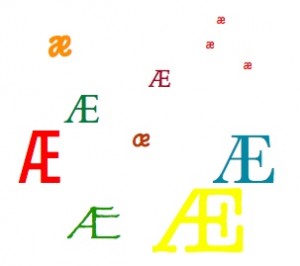 We’ll celebrate the close of 2011 by taking a closer look at the three special characters of Danish. Some readers will find this a bit geeky – but hey, you’re learning Danish, isn’t that quite offbeat already?! The first to go is Æ.
We’ll celebrate the close of 2011 by taking a closer look at the three special characters of Danish. Some readers will find this a bit geeky – but hey, you’re learning Danish, isn’t that quite offbeat already?! The first to go is Æ.
Recently I took a train which I suspect DSB – Danske Statsbaner (Danish State Rails), the national and major train company in Denmark – must have borrowed from our neighbour Sweden. In the ordinary Danish public trains, the so-called InterCity-tog, the names of the next station(s) are shown by yellow pixels flickering across a black panel above the automatic sliding door at the end of each compartment. At the first, sleepy glance I didn’t quite catch it: Näste station… What does Naste mean?
Then it dawned on me that, of course, the running letters just said Næste station (Next station). The Swedish letter Ä corresponds to the Danish Æ, but Æ is such an integrated part of the visuality of written Danish that anything else starts looking confusing!
If your first language is English, you should already be familiar with Æ. It is used in many books as a fancy way of writing the letters A+E: Instead of ’encyclopaedia’, those books have ’encyclopædia’. When two letters are forced to be Siamese twins like that, the resulting symbol is called a ligature. In Danish, however, Æ is not a ligature. It is a wholly independent letter, that just happens to have a ligature origin. Way back in the Roman Empire…
When Danes are abroad and can’t find Æ on any keyboard at the local internet café, we do split the letter, though, writing kære (dear) and kærlig hilsen (sincerely yours) as kaere and kaerlig hilsen.
The Danish Æ sound is close to the E sound of most other languages, for example the E of English pet. It is often impossible to know when to use Æ and when to use E. Each spelling has to be learnt by heart. All the following words have an Æ sound:
kære, knæ, fred, hest, men, mænd, kende, blænde, sværte, hjerte
One rule to note, though, is that
• if an Æ-sounding word is related to another word containing an ’a’, it should probably be written with an ’æ’.
Since mand is the singular, the plural is mænd (not ”mend”).
Whereas the English alphabet stops at Z, the Danish one boldly continues with Æ. So in your Danish printed ’pædia, the island of Ærø is found after Zanzibar rather than Alcatraz… The next letter is Ø, which we’ll be looking at tomorrow.





